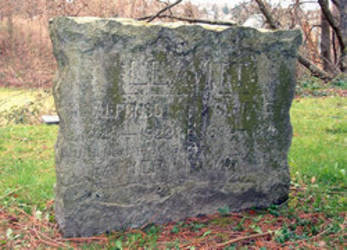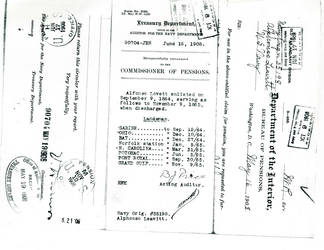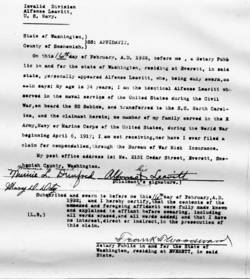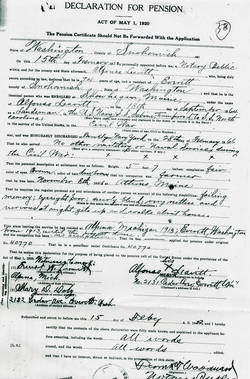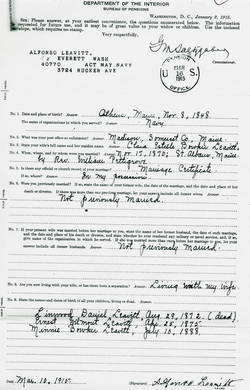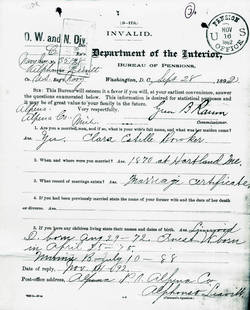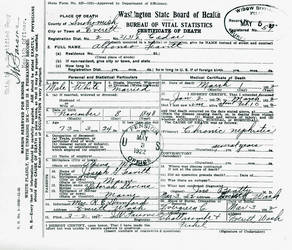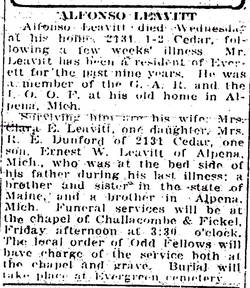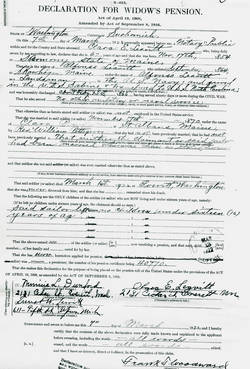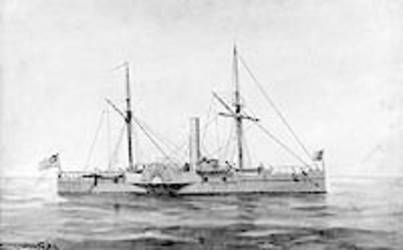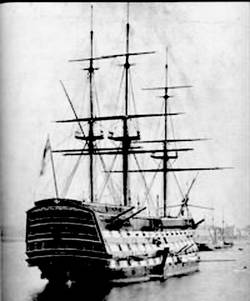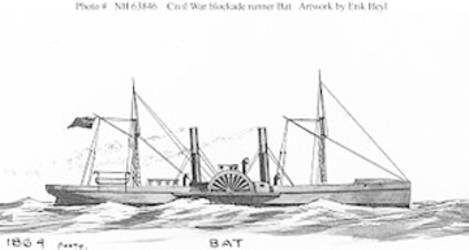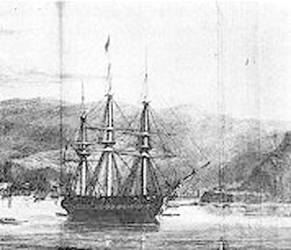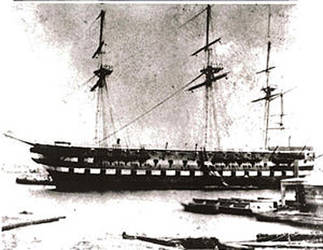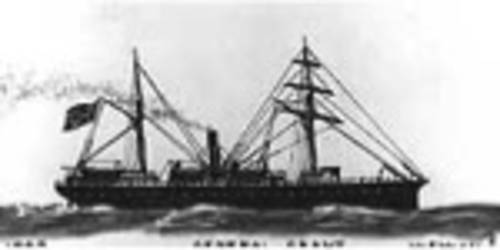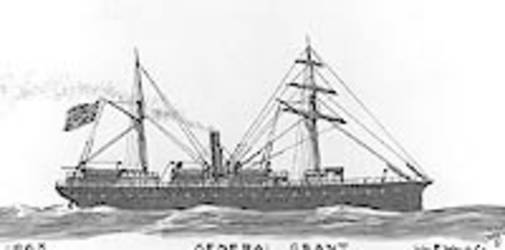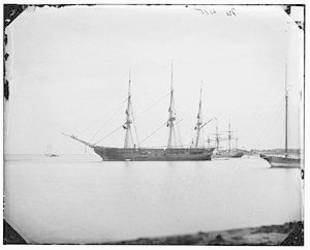Alfonso Leavitt
Representing: Union
G.A.R Post
- Horace S. Roberts Post #139 Alpena, MI
Navy Ship
- USS Grand Gulf
- USS Ohio
- USS Port Royal
- USS Potomac
- USS Sabine
Unit History
- United States Navy
Full Unit History
USS SABINE
Built: New York Navy Yard, New York, NY
Launched: 2/3/55
Commissioned: 8/30/61 (Civil War)
Decommissioned: 7/61 & 1877
USS OHIO
Built: 1817 New York Navy Yard, New York, NY
Launched: 5/30/20
Commissioned: Unk.
Decommissioned: Unk
USS Bat
Built: 1864 Liverpool, England
Commissioned: 12/13/64 (US Navy)
Decommissioned: 5/17/65 WA Navy Yard, WA, D.C
U.S.S. Potomac
Built: Inf. 1819 WA Naval Yard, WA, D.C.
Commissioned: 1831
Decommissioned: 1/13/77
USS North Carolina
Built: 1818 Philadelphia Navy Yard, Phil., PA
Commissioned: 1820 (original)
Decommissioned: 1866
USS PORT ROYAL
Built: New York City, NY
Commissioned: April, 1862
Decommissioned: May, 1866
USS GRAND GULF
Built: Inf. Not Avail.
Commissioned: 9/28/63
Decommissioned: 11/10/65
USS TALLAPOOSA
Built: Boston Navy Yard, Boston, MA
Commissioned: September, 1864
Decommissioned: Ca. 1892 (final)
Regimental History
VESSEL HISTORY: (Sabine)
A ship-rigged wooden sailing frigate, the keel for Sabine - named of a river running along the Texas-Louisiana border - was laid in 1822, but due to various construction alterations, she was not launched until 1855. Her first cruise, to Paraguay, was in 1858. She then operated out of New York with the Home Fleet. In April of that year she assisted in the relief/reinforcement of Ft. Pickens, FL.
After being decommissioned for two months in mid 1861, on 9/9 she was ordered to the Atlantic Blockading Squadron where she first participated on rescue missions involving US warships and troops, but in late 1862 and mid 1863 was involved in the hunt for the C.S.S. Alabama and the C.S.S. Tacony. She then returned to blockade duty in the north Atlantic.
In August, 1864 Sabine was ordered to Norfolk, VA to serve as a training ship for navy landsmen and apprentices. Such was her last wartime assignment.
After the war she was transferred to New London, CT, once again as a training vessel, a role which she continued until 1868. During 1869 and '70 she conducted midshipman training cruises to European and Mediterranean ports.
In 1871, after having received repairs in Boston, MA, she moved to Portsmouth, NH where she served as a receiving ship (induction site) for navy enlistees until 1877. She was then "laid up" at Portsmouth, NH until sold on 9/23/83 to J.L. Snow of Rockland, ME. Her later fate is not known.
VESSEL HISTORY: (OHIO)
Initial work on the Ohio, a three-masted wooden sailing vessel named for the 17th state to enter the union, was begun in 1817. She was launched on 5/20/20 and was off and on in active service for the next twenty years. In 1851, at Boston, MA she became a receiving ship - induction center for new sailors - and remained in this capacity until placed into ordinary (mothballed) once again in 1875. On 9/27/83 she was sold to a private party. Her ultimate fate is not known.
VESSEL HISTORY: (Bat)
Bat, a steel side-wheel steamer named after the flying mammal, was built in 1864 in Liverpool, England. She was to be a blockade runner for the Confederate States of America, but was captured off Wilmington, NC by the Federals during her maiden voyage. She was then added to the North Atlantic Blockade Squadron and operates along the Atlantic seaboard and in the Potomac River until decommissioned. She was sold 10/25/65 in New York. Her later fate is unknown.
VESSEL HISTORY: (Potomac)
The keel of the three-mast frigate Potomac was laid down in August, 1819. Launched in 1822, she joined the U.S. Navy’s Pacific Squadron in 1831. She then circumnavigated the word before returning to the U.S. in 1834. Cruises to South America, the West Indies in the Caribbean and Gulf of Mexico preceded support of U.S. forces during the War with Mexico. During 1855/’56 Potomac served as flagship for the Home Squadron.
With the outbreak of the American Civil War Potomac became part of the Gulf Blockading Squadron off Mobile Bay, AL serving, for the most part as the unit’s stores ship. She then remained at Pensacola, FL as a receiving (induction center) ship until 1867. She was decommissioned and sold in 1877.
VESSEL HISTORY: (Port Royal)
Constructed in New York City, this 1163-ton “double-ender” side wheel steam gunboat was commissioned in 1862 and soon after was in action against the Confederates in the Hampton Roads and James River areas of Virginities. She took part in the bombardments at Sewell’s Point on May 8th and Fort Darling on May 15th. In August she covered the Army’s withdrawal from Harrison’s Landing. Later in 1862 Port Royal operated on the North Carolina Sounds.
The gunboat was next assigned to the Gulf of Mexico blockage, raiding Apalachicola, Florida in April and July, 1863 and capturing a sloop in May. In August, 1864 Port Royal participated in the operations in Mobile Bay, AL, entering the bay with Admiral Farragut’s fleet on the 5th and later assisting in the bombardment and capture of Fort Morgan. Remaining in the Gulf of Mexico beyond the end of the War, she was decommissioned in May, 1866 and sold in October of that year.
VESSELL HISTORY: (Grand Gulf)
Construction information on this 1200 ton screw steamer is not available. Named the Onward, she was acquired by the U.S. Navy in September, 1863 and was almost immediately assigned to blockade duty with the North Atlantic Blockading Squadron outside Wilmington, NC. During this assignment Grand Gulf captured two British blockade runners.
In August, 1864 Grand Gulf was ordered in search of the Confederate raider CSS Tallahassee. Soon, however, she had to give up the search in order to tow another Federal ship damaged by the Tallahassee back to port.
After extensive repairs Potomac was reassigned to blockade duty, this time with the West Coast Blockading Fleet off Texas. With hostilities ended, she served as a prison ship in New Orleans, LA until returned northward for decommissioning and sale. Potomac burned and sank at a wharf in New Orleans in April, 1869.
VESSEL HISTORY: (North Carolina)
Keel for the North Carolina, a large, deep draft wooden sailing ship named after one of the thirteen original American colonies, was laid down in 1818. She was launched 9/7/20 and, for her time, was considered by many to be the most powerful naval vessel afloat. During her history at sea, which because of her deep draft which limited her assignment to areas with deep water ports such as found in South America and in the Mediterranean Sea, she served as flagship of the fleet on two occasions.
In June, 1839 she returned to the New York Navy Yard where she became a receiving ship - induction site for new sailors - until placed in ordinary (mothballed) in 1866. She was sold at New York on 10/1/67. Her ultimate fate is not known.
VESSEL HISTORY: (Tallapoosa)
USS Tallapoosa was a 1173-ton Sassacus class “double-ender” gunboat. Commissioned in September, 1864, in November of that year she was seriously damaged in a storm and had to undergo extensive repairs. She spent the rest of the Civil War with the East Gulf Blockading Squadron.
Tallapoosa remained in the Gulf of Mexico until 1867 when she was laid up. She returned to active duty in 1869 in the role of a dispatch vessel. The following year she carried Admiral Farragut on his last voyage to Portsmouth, NH. Training service at the Naval Academy followed in 1872. In 1873 she was assigned transport work.
In 1874-’75 Tallapoosa was extensively rebuilt after which she continued to serve as a dispatch vessel for nearly a decade until sunk off Massachusetts in 1884. Raised and repaired she was recommissioned in January, 1886 and sent to join the South Atlantic Squadron. She remained there until soled at Montevideo, Uruguay in March, 1892
Soldier History
SAILOR:
Residence: Madison, ME Age: ca. 16 yrs.
Enlisted/Enrolled: 9/64 Madison, ME Rank: Landsman
Shipped Out: 9/9/64 Portland, ME
Mustered Out: 11/9/65 U.S.S. Grand Gulf, New Orleans, LA
Discharged: New York, NY 2/28/66
Highest Rank: Seaman
Family History
Personal/Family History
All available documents, but one, point Mr. Leavitt being born in Athens, Somerset Co. ME to Joseph G. (b.1812 ME), a farmer and Deborah (nee Stevens b. 1819 ME), Leavitt. In 1908 he claimed the true spelling of his first name was Alphonzo. But, again, all available documents, even those signed by the veteran, reflect Alphonso.
Alphonso was the fifth of at least twelve children: Frances (b. 1837 ME), Elizabeth (b. 1839 ME), Warren (b. 1841 or '43 ME), Olive (b. 1842 of '43 ME), Martha (b. 1844 ME), Claretta/Clarette (b. 1844 or '46 ME), Alphonzo/Alphonso (b. 11/8/46), Josephine (b. 1850 ME), Ann Delia (b. 1852 ME), Charles (b. 1854 ME), Eunice (b. 1857 ME) and George (b. 1859 ME). While no information exists regarding his childhood or formative years, Alphonso obviously grew up as a farm boy. In his mid teens the 5'5 1/2", blue eyed, dark complexioned youth left the farm to join the U.S. Navy.
Landsman Leavitt was first assigned to the school/training ship Sabine stationed at Portland, ME. Later in September he was aboard the receiving ship U.S.S. Ohio. By 12/10 he had joined the crew of the U.S. S. Bat, but in late December he entered the Portsmouth, NH Naval hospital suffering from what was then an unidentified illness. A few days later he was discharged in Portsmouth, but admitted to the hospital at Norfolk, VA. On 1/5/65 he was transferred to the receiving ship North Carolina. From there it appears he was shipped to a hospital in New York where he was diagnosed with pneumonia. By 2/3 his condition had improved enough to be put to work around the hospital, but did not return shipboard until 4/12 when he joined the crew of the U.S.S. Potomac.
On 6/5/65, with the Rebellion over, seaman Leavitt was assigned to the U.S.S. Port Royal in New Orleans, LA. From the Port Royal he moved, on 9/30, to the gunboat U.S.S. Grand Gulf. He remained aboard this vessel until 11/9 when he rejoined the U.S.S. Port Royal then stationed in Galveston, TX. He was reportedly on this ship until taken aboard the gunboat U.S.S. Tallapoosa in early February, 1866 for transport to New York and final discharge. While in the navy seaman Leavitt had done what many sailors did then, and for that matter, now; he was tattooed. Seaman Leavitt received a star tattoo on the back of each wrist.
One source indicated that after leaving the service, as perhaps a final, youthful fling, Alphonso went west to Virginia City, Montana. If so, he was likely in search of the silver riches being mined there. However, he was apparently not successful in his search as, by 1868, he had returned to Athens, ME, first to the home of his parents and then to a household of his own.
On 11/17/70 in St. Albans , ME Alphonso married Clara Estelle Bowker, a young Athens woman born 3/17/54 in Harmony, ME. Shortly thereafter the couple moved to Alpena, Alpena Co., MI where their first child, Linwood Daniel was born 8/29/72. The union would ultimately produce three additional children, but only two apparently survived as only two names are recorded: Ernest Wilmout (or B), 4/22/75 MI) and Minnie B. (b. 7/10/88 MI).
The Alpena, MI U.S. Census of 1880 noted Alphonso as labourer. Most of the 1890 census was destroyed by fire, so there is no listing for Alphonso for that year. There is no occupation notation in 1900, but a document from 1908 noted he operated a sale barn for horses. In 1910 he was listed as a horse salesman.
In 1908, while in Michigan, Alphonso applied for a U.S. Government pension based his Civil War sailoring. In doing so he claimed he could not do manual labor because of (shoulder) rheumatism and affection of the right lung contracted while in the service. An undated document pertained to other ailments. At some point Alphonso was granted a pension of $12 per month. That amount was later increased to $14, then to $16, to $20, to $24 and, by time he died at age 73.3 years, to the princely sum of $72.
By 1915 both Alphonso and Clara were residing in Everett, WA with daughter Minnie and husband, Raymond E. Dunford. When the move to the Puget Sound area of the Pacific Northwest had been made is not known, no is the reason. Possibly, however, it was due to Alphonso’s declining health as Minnie later would claim that by 1920 she was her father's personal attendant. In mid February, 1922 she reported her father's eyesight was poor and his memory failing to the point of being almost blank. He could allegedly only occasionally recognize his nearest friends. Being very nervous and restless at night Alphonso would get out of bed and walk around the house. On 2/16/22 when asked to sign a document he could only make "his mark."
Alphonso Leavitt died 3/1/22 in the Dunford home located at 2131 Cedar St. Everett, WA. Cause of death was documented as Nephritis (kidney disease) of several years duration. According to his Everett Herald obituary he was survived by his wife, two children (Ernest and Minnie), one brother and one sister. Burial was in Everett’s Evergreen Cemetery.
Clara died 10/26/25 in Everett. She was buried beside Alphonso.
Cemetery
Buried at Evergreen Cemetery Everett
Row: 32
Site: 5
Adopt-a-Vet Sponsor
Scott Putzier
Woodinville, WA
